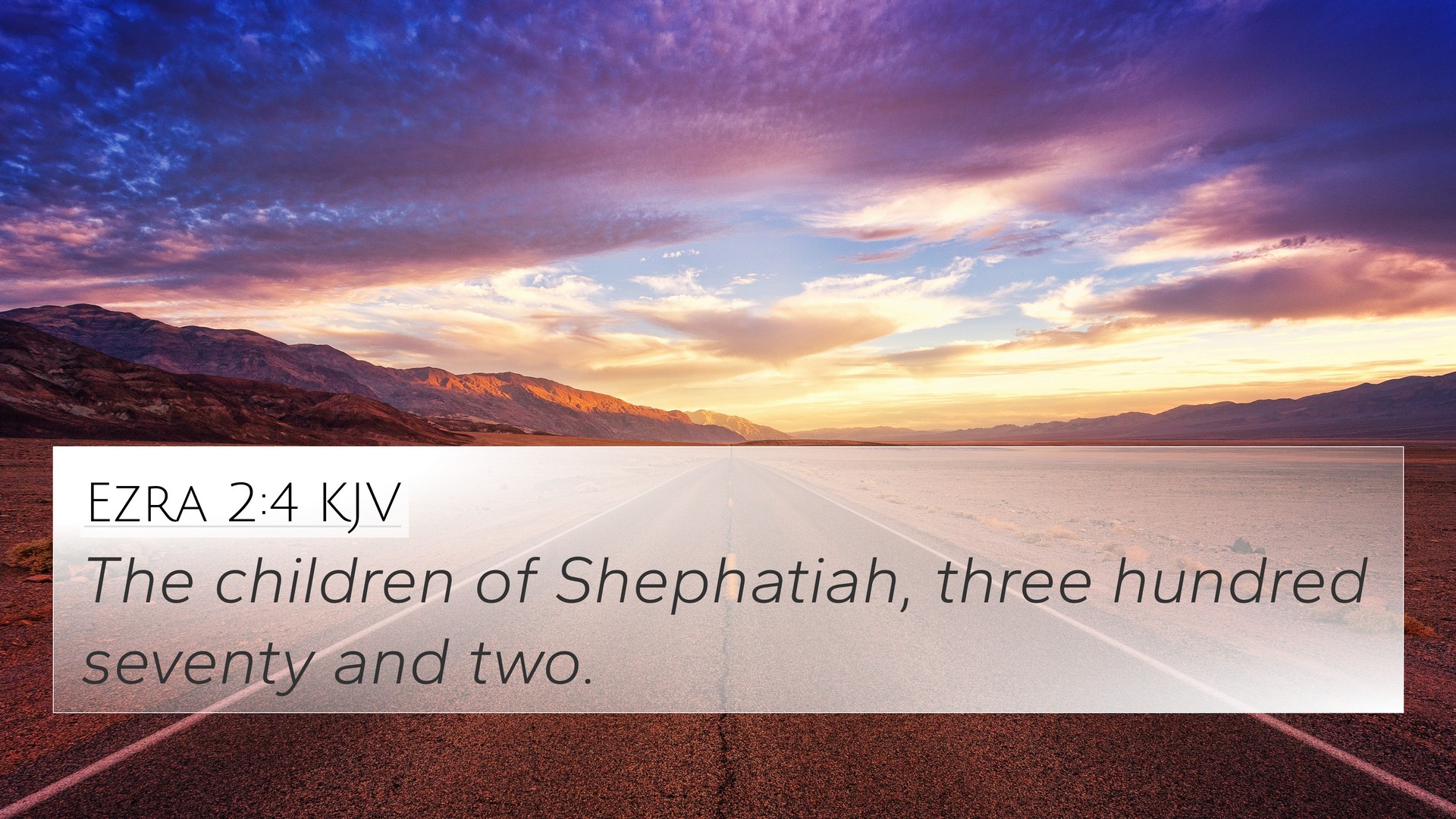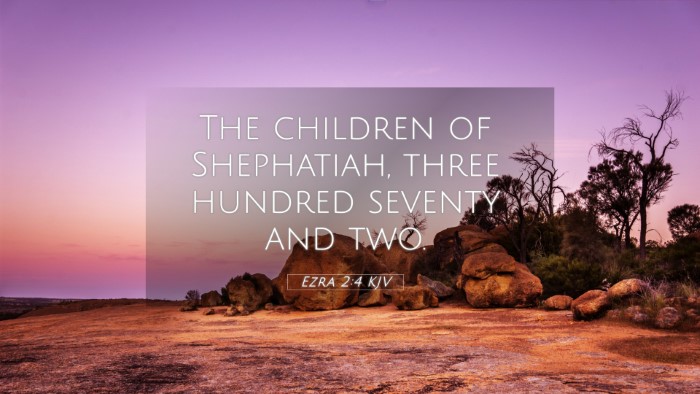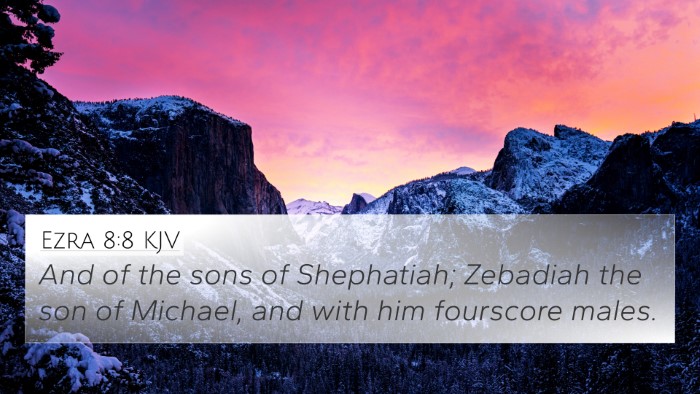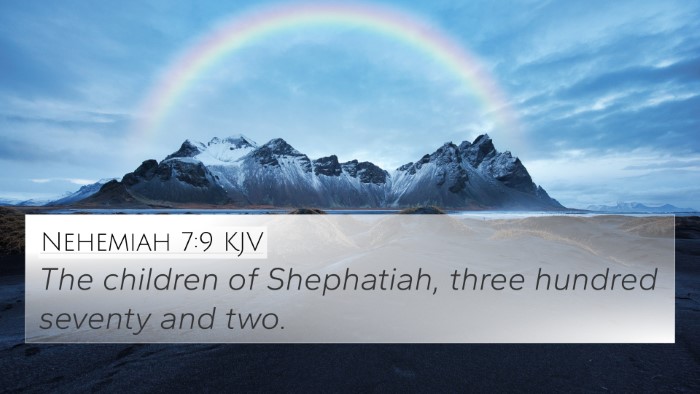Understanding Ezra 2:4
Ezra 2:4 presents a list of the descendants of the people who returned from the Babylonian exile to Jerusalem. The verse reads:
"The children of Pahath-moab, of the children of Jeshua and Joab, two thousand eight hundred and twelve."
Summary of Biblical Insights
This verse carries significant implications regarding the identity and heritage of the returning Jewish exiles. The names mentioned are essential as they establish a connection to the past and the faithfulness of God in restoring His people. Let’s explore insights from various public domain commentaries to deepen our understanding.
-
Matthew Henry’s Commentary:
Henry emphasizes that this return was a fulfillment of prophecy and God's promises to Israel. The mention of specific families, such as Pahath-moab, highlights God's concern for the genealogical records of His people, showing their importance in the community of faith.
-
Albert Barnes’ Notes on the Bible:
Barnes interprets this verse as an affirmation of both the numerical strength and the unity of the returning exiles. The detailed counts of families illustrate not just the physical return, but a spiritual renewal among the Israelites. This reinforces the idea that God preserves a remnant of His people.
-
Adam Clarke’s Commentary:
Clarke provides historical context, indicating that the names listed represent significant families of the tribe of Judah. He notes that Pahath-moab likely refers to those who had intermixed with the Moabites, suggesting a diverse background among the returning exiles. This diversity may reflect the trials faced during their exile.
Connections Between Bible Verses
The genealogies and lists of returnees found in Ezra 2:4 can be cross-referenced with several other biblical texts to enhance understanding:
- Nehemiah 7:8: This passage provides a similar listing of those who returned, establishing consistency and confirming the historicity of the return.
- 1 Chronicles 9:2: Chronicles discusses the genealogy and shows the importance of family lineage in Israel’s history.
- Jeremiah 29:10: This verse speaks of the 70 years of Babylonian captivity and God’s promise to restore His people, setting the stage for the significance of the returnees.
- Ezekiel 36:24: The prophetic declaration that God would gather His people from the nations supports the return after exile as part of divine fulfillment.
- Isaiah 44:28: This prophecy about Cyrus, who would allow the Jews to return to Jerusalem, serves as an affirmation of God’s sovereignty and plan for His people.
- Haggai 1:14: This is a reminder that God stirred the hearts of the leaders to rise and rebuild Jerusalem, linking back to the unity mentioned in Ezra 2:4.
- Zechariah 8:7-8: Highlights the joy and return of the children of Israel, resonating with the themes of restoration found in Ezra.
Comparative Bible Verse Analysis
In comparative Bible verse analysis, we see that Ezra 2:4 relates not only to its immediate context but also to broader themes throughout scripture such as restoration, identity, and God's covenantal faithfulness. The return of the exiles is analogous to spiritual renewal found in the New Testament through Christ.
Cross-Referencing Biblical Texts
The practice of cross-referencing Biblical texts enhances our understanding. By linking verses, we can interpret Ezra 2:4 through the lens of other passages that illuminate the themes of exile and return:
- Luke 4:18-19: References Jesus’ mission of restoration, echoing the purpose of Ezra's return.
- Romans 11:1: Discusses God's unbroken covenant with Israel, connecting back to the significance of the returning exiles.
- John 18:37: In Jesus' proclamation of truth, we see the realization of God’s kingdom that the exiles would ultimately also point toward.
Thematic Bible Verse Connections
Several themes arise from this passage, making it rich for thematic Bible verse connections:
- Restoration: Numerous passages discuss God’s promise to restore His people, signified here by the physical return.
- Family Heritage: The emphasis on genealogies throughout both Old and New Testaments points to the importance of knowing one’s spiritual roots.
- Presence of God: Many verses emphasize God’s presence with His people, tying into the returned exiles’ rebuilding efforts as they sought to restore worship.
Conclusion
Ezra 2:4 serves as a vital link in understanding the restoration of God's people. Through cross-referencing Biblical texts, thematic connections, and insights from public domain commentaries, we see that this verse is more than a mere listing; it encapsulates God's faithfulness and the importance of community identity within the people of Israel.
Tools for Bible Cross-Referencing
For those seeking to deepen their study of scripture, employing tools for Bible cross-referencing is recommended. Resources such as a Bible concordance or a cross-reference guide can aid in exploring connections across different books and themes within the Bible.
Applying Cross-Referencing in Study
Consider implementing cross-referencing Bible study methods in your personal studies. By identifying connections between verses, you can cultivate a richer understanding of God’s word and how His promises unfold throughout scripture.




